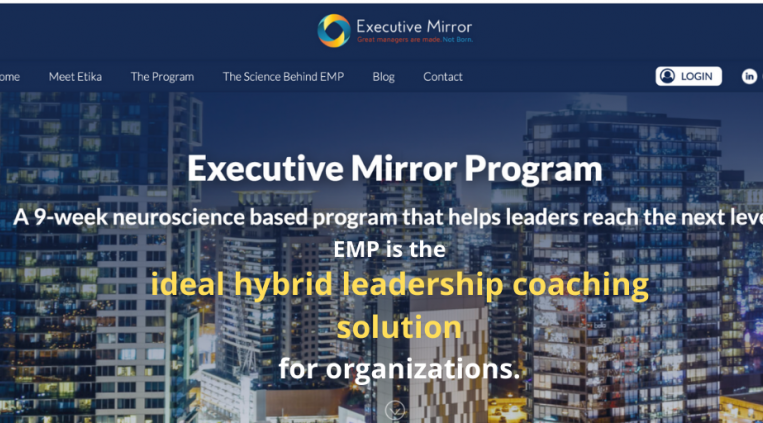
How a coach can help clients move on

What seems to be the dream of every number two in an organization with regard to corporate development career path? To become number one, of course. But becoming number one is much farther than a hop, skip, and a jump.
Mark had spent the last eleven years in two different VP positions - always with one eye on his target: president, the natural pinnacle of a corporate development career path. And with the company’s recognition of his outstanding record, Mark was always sure that his target was well within reach.
But there’s recognition...and there’s recognition. Sure, Mark was constantly praised for his performance and results, but the proof of the pudding never came in the form of a promotion to president.
I met Mark one evening at my office. He quickly explained to me that seeing me was not his idea:
“It’s my wife, Kathy. She’s really been on my case the last couple of years. She can’t seem to get her head around the fact that I work until 8:00 pm most evenings, let alone Saturdays, and I still haven’t been promoted to president.”
I continued to listen.
“But to tell you honestly, Etika,” he admitted. “How can an executive coach really help me? No disrespect to you, of course, but I’m the only one that knows what’s happening at my company. I don’t think that any psychological theories will really be of any help.”
I invited Mark to sit down and he hesitantly followed my lead. He continued:
“Believe me, Etika, if you could help me get Kathy off my back, I would be grateful, but isn’t this a tall order for someone like you?”
“I like your candidness, Mark,” I answered. First let’s set some ground rules. You can say anything you want to me, even if you think it might be hurtful.”
“And guess what, Mark, I continued. “Maybe you’re right. Maybe I can’t help you. It’s happened before.”
Mark seemed slightly shocked by my response. After all, what kind of executive coach says they might not be able to help their client? But his face seemed to relax and he became more open.
“Look, Etika, I don’t have anything against executive coaches or other consultants. I even have some subordinates who’ve gotten a lot out of coaching sessions. I just think that it would be sort of mission impossible to help someone with my experience. How could you possibly know what I’m going through?”
“I respect what you’re saying,” I answered. “But let me ask you a question.”
“Sure,” Mark said.
“When a couple sees a therapist because they’re considering a divorce, do you think that in order for the therapist to treat the couple, the therapist needs to have personally experienced a divorce?” I asked.
Mark cracked a slight smile, showing me that he understood my point.
“You don’t have to answer, I can read your face,” I offered. “So Mark, if a therapist doesn’t have to have experienced divorce to treat a couple with marital issues, why do you think that an executive coach needs to have been a CEO?”
I continued, “Why don’t we think of these professionals as being competent in helping others navigate their own experiences, rather than as dispensers of marital or managerial advice?”
“Why is this so important?” Mark asked.
“Because I want you to really believe, Mark, that an executive coach can help you achieve your career aspirations,” I answered.
“Of course, you don’t have to be convinced right away,” I conceded. “But if you’re already here, I’d like for you to at least leave here with some insight as to why you aren’t open to getting any help.”
Mark smiled cooperatively. “Etika, as I told you before, I’ve been a heck of a VP the last eleven years. I honestly don’t think there’s anything that I can do to get myself promoted. It’s just not the right time now for the company.”
“I understand your point, Mark,” I answered. “But would you say that being number two is the same as being number one?”
“To tell you the truth,” Mark answered. “I used to think it was, but lately I’ve realized that the two positions are very similar in terms of day-to-day, but oceans apart when it comes to responsibility.”
I then asked, “Can you try to imagine situations in which number two does an excellent job but can never be number one?”
Mark responded, “Well, theoretically, yes, I suppose, but you’ve got to understand that this is not my situation.”
I smiled.
“Why are you smiling, Etika?” Mark asked.
“Because you really believe in what you’re saying,” I answered. “You see yourself as ready to be number one, yet eleven years have elapsed and you still aren’t there.”
“If you don’t mind, Mark,” I asked. “Let’s explore why you think that getting help from a coach won’t work.”
“Sure,” Mark responded. “First of all, no one else has my experience, so what could they possibly add?”
“And second, I know that I’m ready to be number one; it’s just a matter of the right timing.”
“And when I come to think of it, Etika, I came to you today because of these two points, but thanks to you, it’s really just the second one.”
“Glad I could be of help, Mark,” I offered.
“Can I ask you something, Etika?” Mark asked.
“Of course,” I responded.
“Judging from our conversation so far, do you think I need help?” Mark asked.
“Well, Mark,” I answered. “As I see it, that’s really not the important question here. What’s important is that we can only help people who think they need help - and are willing to receive it.”
“And regarding what you’ve expressed today, I’m sure everything is well-founded, as it’s based on your personal experiences and circumstances, so I really can’t argue with any of it.”
“But I’m not going to let you leave here empty-handed,” I said. “I’d like you to consider a few things.”
“I’m all ears,” Mark said.
“When someone is stuck in a certain way of thinking, on one hand, it’s good because it shows determination. But on the other hand, it prevents us from seeing the whole picture. We only see a slice of it.”
“Yes, I can see that,” Mark said.
“And regarding the question of the right timing, I agree with you, but then you’ve given up any control over your own fate. I would encourage you to look for something you can do, rather than just wait for the right time,” I advised.
“That is something to think about, Etika,” Mark said.
“And from my experience, Mark, success blinds us, and then we realize too late that we’ve missed out on some very important things, which are often important changes.”
“Wow, I’ve never thought of success as something that could be so dangerous,” Mark said.
I got up and shook Mark’s hand.
"Mark, I really enjoyed meeting you today. I hope you’ve left with something to think about for your future.”
“I certainly did, Etika,” Mark answered. He pulled out his phone. “Can we schedule our next meeting, let’s say, for Wednesday?”
“I’d love to work with you, Mark,” I answered. “But let’s give you some time to think about why you’ve changed your mind about executive coaching. When you’ve gathered some insight, give me a call and we’ll schedule our next meeting.”
“Will do,” Mark answered.
And always remember:
Great managers are made. Not born.
get your weekly free blog update
Coaches: have you considered how hybrid coaching can increase your business?

For those of you reading about my meetings with Jennifer for the first time, here’s a short recap: Jennifer is a successful executive coach whom I mentored for several years. Recently, one of her major clients replaced her workshop with a digital course, rattling Jennifer’s confidence and prospects about the future of face-to-face coaching, which she felt would ultimately affect her executive coaching rates. In the last two posts, Jennifer and Etika met at a coffee shop, where they began to explore the advantages digital tools can provide to their coaching practices.
After my last meeting with Jennifer, I received a notice about a digital learning meetup taking place at the beginning of next month. Thinking that this would be a great opportunity to introduce Jennifer to digital learning tools, and hopefully allay her fear of reduced executive coaching rates, I forwarded the invitation to her and wrote her a note inviting her for coffee at the after the meetup at the end of the day.
After a truly stimulating meetup, with all kinds of innovative digital tools being presented and demonstrated by dozens of firms, I sat down in the break area and waited for Jennifer.
“Etika!” she shouted. “There you are. What an amazing meeting! I can’t believe all of the awesome innovations I’ve seen. So many ideas. Such brilliance.”
I smiled. “I’m so happy you enjoyed today, Jennifer.” I gave her a hug.
“I’m blown away, Etika. Now I’m starting to understand what you’ve been getting at all along,” said Jennifer. “Etika, you told me at our last meeting that you’ve also been developing something, right?”
I answered, “Well, it’s actually all developed...and in use. But it took me over five years until I felt I’d gotten it right.”
“Five years?” Jennifer was amazed.
“And add to that the 35 years of experience and knowledge it’s based on,” Etika added. “But now it’s being successfully used by managers all over the world.”
Jennifer said, “Enough suspense, Etika. Tell me about it!”
“With pleasure,” I answered. “But first, do you remember what I said are the two main advantages of digital learning tools?”
“I certainly do,” Jennifer quickly responded. “I’m still a good student. The first is that because of the anytime/anywhere delivery, digital tools allow us to help many more clients, especially those who might be too busy for face-to-face coaching.”
“You really are a good student,” I said. “Go on.”
“And the second one,” she said, “Is that we can offer a wider range of solutions, therefore ensuring that clients receive customized service.”
“Bravo!” I congratulated. “Well, these two principles guided me in my development of the Executive Mirror Program.”
“The Executive Mirror Program?” Jennifer repeated. “Tell me more.”
“The Executive Mirror Program, or EMP for short.” I continued, “It’s an online course for managers who are stuck in their career. They feel as if they are never going to get promoted and have begun losing hope.”
“From my practice,” Jennifer said, “I’ve noticed that this is a huge niche and it keeps growing.”
“No doubt.” I explained, “It seems that with hypercompetitiveness, more managers are fighting for their careers than in the past. In fact, 70% of managers these days define themselves as stuck to some degree.”
“That’s a huge number, Etika,” Jennifer responded. “So there’s your first principle, helping as many managers as possible - wherever they are.”
“Bingo,” I answered. “With so many stuck managers, all of the face-to-face hours in the world wouldn’t be able to help them all. That’s why the self-paced online EMP is a perfect solution for them.”
“It certainly is. And what about your second principle, Etika,” asked Jennifer.
“You mean customized learning, I assume. Well, thanks to sophisticated algorithms, the EMP is actually dynamically tailored for each and every client. No cookie-cutter programs,” I proudly stated.
“So as a coach, you can actually provide a highly-customized solution to each of your clients,” Jennifer added.
“Yes,” I said. “Something that would’ve been impossible without digital tools.”
“But what about the personal touch, Etika?” Jennifer asked. “Aren’t there managers out there who still want to talk to a live coach.”
“Of course, Jennifer,” I agreed. “And that’s why the EMP can be seamlessly combined with face-to-face coaching. In the digital learning world, we call this hybrid coaching.”
“I see,” Jennifer answered. “A hybrid between online and face-to-face.”
“Indeed,” I said. “And that’s why I’ve developed a certification course for coaches who’d like to integrate the EMP into a hybrid coaching program.”
“That’s really forward-thinking, Etika,” Jennifer said. “So the EMP can also be used as part of a live coaching program.”
“That’s right. Maximum flexibility in delivering a tailored experience,” I said. “This is a major advantage that digital learning tools can offer us.”
I added, “And don’t forget, Jennifer. Our clients are already experiencing 24/7 learning online, whether it’s checking out a series of YouTubes on a subject or taking a full university course.”
“So you’re saying our clients will come to expect digital learning tools?” Jennifer asked.
“No doubt,” I answered. “And if we want to remain at the forefront of our field, as you’ve done so far, Jennifer, we’ve got to meet their expectations.”
“Etika, I think that I now really understand where you’re coming from,” Jennifer said. “It’s amazing that you had the foresight to predict all of this five years ago. I feel like such a dinosaur.”
“Nonsense, Jennifer,” I answered. “Like our clients, we avoid change, so sometimes we don’t let ourselves see what’s really happening around us.”
“Well, you’ve certainly opened my eyes, Etika,” Jennifer admitted.
“I’m glad, Jennifer. That’s what being your mentor has always been about,” I responded.
“So when do I get to check out your EMP, Etika,” Jennifer asked.
“Why don’t you come by my office tomorrow at 9, Jennifer,” I offered. “I’ll show you a full demo. I’m sure you’ll find it both innovative and fascinating.”
“I’m sure of that, Etika. Looking forward,” Jennifer said.
With that, we got up, hugged as usual, and left the conference center, both of us contemplating our bright future with the help of digital learning tools.
And always remember:
Great managers are made. Not born.
get your weekly free blog update
COMMENTS
My holiday wishes “may all your dreams come true”

At this time of year, as we gather with our loved ones to celebrate the holidays, we find ourselves reflecting on our lives - family, friends, and career. Often, we ask ourselves where we are in achieving our dreams. Are we completely satisfied? Are we possibly a little disappointed? This is probably why one of the most popular greetings during this time of year is “may all your dreams come true.”
So what about your career dreams? Have you met your own expectations? To help you along, allow me to wish you 4 things this holiday season.
Holiday Wish #1: Unleash your dreams.
At this magical time of year, dare to dream what you’ve never dreamed before. Dreams allow us to think “out of the box” - to transcend the normal borders of our imagination - beyond how to measure success at work. Use your innate ability to dream about your dream career - especially if it seems to be “the impossible dream.” You see, such “impossibility” is actually the stuff dreams are made of...and facing impossibility in your dreams is the only way to overcome it in life. Here are four useful reminders that will hopefully get you dreaming:
Just as in fairy tales, in real life, dreams are meant to come true.
Every great thing we’ve ever known - ideas, inventions, cures - started with a dream.
If you don’t have a dream, you can’t make it come true.
Holiday Wish #2: Visualize your success.
This holiday season, do overtime. No, not at work - visualizing. Clearly visualizing the results of your dreams is a crucial bridge towards making the impossible a reality and part of how to measure success at work. This is because of the simple fact that anything you can visualize, you can accomplish.
So start by visualizing yourself in your corner office. What does it look like? Where is your desk? What’s the view outside your window? Then visualize yourself in different situations in your new job. What’s it like to run a staff meeting? Give an important presentation? Determine a budget? Don’t worry if your visualizations are a little dull or blurred at the beginning. The more you visualize, the sharper and more detailed the images will become. And make sure that your other senses (hearing, smelling, feeling, maybe even tasting) get in on the act as well. The more senses you involve, the more you’ll actually really know what it’s like to have your dream job. So close your eyes and get to work.
Holiday Wish #3: Put your visualization into words.
After you’ve visualized your dream job in as much detail as possible, seize the opportunity to express it in words. When we put our dream job into words, we make it concrete so that we can set the goals needed to turn it into reality. When putting your visualization into words, here are some general questions you should answer:
1. What is your dream job?
2. When do you want to begin it?
3. What are some of the major milestones you’ll need to accomplish along the way?
So start putting things into words - whether you write them down or record them, now is the time.
Holiday Wish #4: Plan it out.
If you’ve gotten this far (with or without the egg nog), consider how you’ll start realizing your dream as you begin the new year. Of course, this isn’t the time to make a very detailed plan, but while you’ve got things going, it would be a good idea to think about the following:
1. Break down your overall dream job goal into smaller, more manageable “mini-goals.”
2. Assign a rough due date for each of these mini-goals.
3. Keep your eyes on the ball. No backup plans.
4. And of course, believe in your dreams!
And finally, I’d like to wish you a very joyous holiday season, filled with love, happiness, and peace for all.
Best wishes
Etika
P.S. And don’t forget. Great managers are made. Not born.
get your weekly free blog update
COMMENTS
Coaches: listen to your heart when accepting new clients

“What’s bothering you, Marlene?”
As I watched her playing around with her curry, I understood that my friend and coaching colleague wasn’t up to eating, even though we were having lunch at her favorite Indian restaurant.
“I think I have to turn down a client and I really feel guilty,” she answered as she continued to shift her curry from side to side. She hadn’t even touched her wine, either.
“So if you’re feeling so guilty, why not consider taking them on?” I probed.
“You know the story, Etika. We’ll have two or three sessions and then I’ll begin wishing I hadn’t accepted them, even at generous executive coaching rates” she answered.
“Then it actually looks like you’re smart for turning them down. So why is it bothering you so much?” I asked.
“Well, without getting into too much detail, this time it’s the CEO of a very high profile hi-tech company, with promising executive coaching rates.”
“Impressive!” I commented.
“Yes, but if I tell you about our first meeting, you’ll understand where I’m coming from,” Marlene said.
“I’m all ears.”
“Well,” Marlene began. “It started off with the way she spoke to me on the phone. Something in her very cold tone told me that I shouldn’t move things forward. But I did,” Marlene lamented. “I guess it was because she’s so high profile.”
“Fair enough. Been there. Done that,” I admitted.
“So, we set up a meeting at her office the next day. Without even a minute of small talk, she sat me down in front of her desk and complained to me that her team doesn’t get along with her,” Marlene recounted.
“Well, from the sound of how she spoke to you, I’m not that surprised,” I interjected.
“Indeed. But then she told me that the reason she wants to hire me is to force the team to cooperate with her!”
“Force? That’s a pretty strange way of doing things,” I said surprisingly.
“Wait, Etika, here’s the best part,” Marlene continued. “In the same breath, she asserted that she doesn’t see herself as part of the problem and that she won’t be involved in the coaching process.”
“Pretty low in the self-awareness department, I’d say,” I answered.
“And,” Marlene added. “At the end of the process, she wants a report of which employees I was able to change and who needs to be fired.”
“Is this person for real?” I asked flabbergasted.
“One hundred percent,” Marlene answered. “And she even tried to sweeten the deal by saying that if I succeed, I’ll have a lot more work at her company.”
“So you were tempted?” I asked.
“I don’t know if I was tempted or confused,” Marlene admitted. “I think that I wasn’t really sure how to respond, so I began asking her a few questions about her relationship with her team, what she expects, etc. All of it quickly confirmed my suspicion that she was just looking for someone to create an army of robots.”
“Sounds like an accurate diagnosis,” I commented.
“And so I pretty much instantly realized that this wasn’t the kind of coaching work I could or wanted to do,” Marlene concluded.
“I wholeheartedly concur,” I responded. “So why are you upset?”
“Well, the minute I realized this, I became overridden with guilt - professional, business, and even personal guilt,” Marlene said. “So I didn’t tell her ‘no’. In fact, our meeting ended with the CEO instructing her personal assistant to set up a series of meetings between the team members and me. But as I said, I don’t feel that I can go through with it. Yet the guilt is still there.”
“I get it, and I understand where you’re coming from, because, as I said, I’ve been there,” I answered. “So let me tell you a little bit about how I deal with occasional guilt.”
“Yes, Etika, please do,” Marlene urged.
“First off,” I began. “Whenever any guilty feelings begin to appear, I try to nip them in the bud.”
“Makes sense. But how?” Marlene asked.
“By always developing and maintaining my self-awareness, both as a professional and as a person,” I explained. “The better we know ourselves - what’s right for us, what’s not right for us, who we can help, and who we can’t, the better our lives will be.”
“I’m not sure I’m following you,” Marlene admitted.
“You see, Marlene, the sharper our awareness is, the easier it is to make the right choices, whether they are professional or personal. And when we’re sure our choices are the right ones, we don’t feel guilty about them,” I explained.
“So are you saying that you can just turn down a client and not think twice about it?” Marlene asked.
“You bet. In fact, I’ll even feel good about it,” I answered.
“Because you’ve made it very clear to yourself by staying in tune with your self-awareness,” Marlene interjected.
“Exactly,” I said.
“So I’ve got some serious work to do with my self-awareness,” Marlene concluded. “Etika, would you mind meeting with me a couple of times to mentor me on raising my self-awareness?”
“You don’t even need to ask,” I answered. “I was just going to suggest we meet next week for lunch. But this time, I want to see you enjoy your food!”
“You know, I’m already feeling better,” Marlene said. “And I have a suspicion that as soon as I call a certain CEO, my appetite will return.”
I raised my glass of wine and proposed a toast, “to not feeling guilty”.
And always remember:
Great managers are made. Not born.
get your weekly free blog update
COMMENTS
Pro-bono coaching during uncertainty?

As if corporate life is not tough enough, the recent economic uncertainty has added even more stress and tension to the lives of our clients. Now, more than ever, our clients need us. Yet organizations are now watching every penny, and coaching is often one of the first expenses to be deleted from the budget. So as coaches, committed to our clients’ success, especially in the eye of the economic storm, should we provide our services for free?
If you’ve been in the coaching business for more than ten years, you’ll probably remember the dramatic downturn following the 2008 financial crisis. And there have been other similar situations, such as the 2000 dot com bust as well. My point is that if you haven’t already, you’ll be experiencing your share of sharp dips, like the current one, throughout your coaching career.
What’s common to times of trouble is that, as coaches, we painfully experience the gap between the declarations of CEOs that “human capital is key to success” and the actual resources management will invest to protect their people in times of strife.
For many years, I was frustrated by this gap, especially in light of “hints” I received from big corporates to “pitch in” and provide my services pro bono. In fact, recently, colleagues and supervisees have gotten in touch to ask for advice on this very issue. On one hand, their clients are in great need of coaching, and yet on the other hand, they face difficulty in affording coaching sessions. Then our conversations usually spiral into two key questions: “Why do my clients feel comfortable asking me to work for free when they would never even dream of engaging another professional without paying them? Why is coaching seen as different?”
My answer to the first question is related to the second one. Coaching is different. And you are perceived by your client as the only person who can help them weather the storm. People need coaching all of the time and under all circumstances, whether the market is up or down....but especially when it’s down.
Once I internalized this myself towards the beginning of my career, I simply disconnected the “logical” equation of need equals payment. When organizations tighten their belts and freeze coaching services, this doesn’t mean that our services aren’t needed. In fact, they are badly needed.
With the uncertainty brought on by the current economy, my clients are getting in touch in droves. And yes, I feel it’s my duty as their coach to be there for them. Don’t get me wrong; I’m not ignoring the fact that I am providing them with my professional services without full (or any) payment. However, what I do know is that I am needed.
But I don’t have all of the answers. For example, I don’t know how many people I can help, and I don’t know how long I’ll be able to help them for. But for the time being, I’m framing the work I’m doing as “volunteering,” which I have always integrated into my life anyway.
I know that with our chaotic lives and great uncertainty, volunteering might not be a viable solution. There have been periods in my career when I’ve been more limited than I am today. What I’d like for you to understand, as a fellow coach, is that you are key to your clients’ success - no matter what the budget people might tell you.
Have you been approached by clients to provide pro bono or reduced rate work? How do you feel about it? Are there any creative ways we can help our clients during the current turndown?
And always remember:
Great managers are made. Not born.
get your weekly free blog update
COMMENTS
What are some of the opportunities that online coaching programs can offer coaches?

For those who haven’t had a chance to read my first post about Jennifer, I’ll recap: Jennifer, a star executive coach whom I supervised came to me one day very upset. She’d just found out that a company she ran leadership seminars for had “replaced” her with an online program, one of the new career advancement solutions.
Jennifer and I discussed this over a cup of coffee, in which I told her my point-of-view: Online coaching courses are a very big opportunity for coaches, as they’ll let us provide a larger number of career advancement solutions to a wider audience. This piqued Jennifer’s curiosity and we decided to meet again.
Yesterday afternoon, Jennifer walked into the coffee shop around the corner from my office with a smile on her face, a much different expression than the one she’d worn the last time we met. After a little bit of catching up and ordering our usual lattes, Jennifer began:
“Etika, I have to admit that I left our last meeting a little confused. I had come in so angry and hurt by my client but left with a glimmer of hope. It took me the whole weekend to really sort out how I feel, but I want you to know that I’m all ears regarding how you see online coaching tools as a vehicle to grow my practice.”
I smiled, as I was really pleased that Jennifer had taken on my advice, especially since I knew the potential that online tools could add to her already successful business.
“That’s what I like to hear,” I told Jennifer. “I’ve done a lot of research regarding online coaching tools and I want to share my main findings.”
Taking out a pen and notepad, Jennifer answered, “Ready when you are.”
“Great,” I answered.
“Here’s the headline: Online courses are not only going to increase in number but also develop in directions we’re not even aware of.”
“Got it,” Jennifer answered. “That sounds reasonable...like so many other technological developments.”
“It does,” I said, “But I want you to know how many coaches I’ve met who spend...no...waste valuable time discrediting online courses. What they don’t realize is that what they’re really doing is expressing fear.”
Jennifer nodded her head in agreement, but asserted, “Well, they are justified in being afraid. Look what happened to me!”
“Fair enough,” I said. “But categorically rejecting every online solution only because it’s online is ridiculous. Like everything, there are many different levels of quality.”
“I see what you’re, saying, Etika,” Jennifer said. “And it doesn’t put the coach in a very good light either, I suppose.”
“Precisely,” I said. “So rather than viewing online courses as the enemy and spending time putting them down, better to see how we can begin to accept them as real players in our industry.”
“OK,” Jennifer followed.
I continued, “Once we accept them as players, we can stop being afraid and start seeing the kinds of opportunities they’ll present to us.”
“Like what?” Jennifer asked.
“Well, the biggest one I’ve identified so far, Jennifer, is how online tools can help us, as coaches, provide the best solution possible for our clients.”
“Yes, I remember your saying something about this the last time we met,” recalled Jennifer.
“Good memory! Now, try to think about how many times your clients have cancelled or put off meetings because they said they didn’t have enough time.”
“Ugh. More than I’d like to think about. It always gets me so upset when I have to rejuggle my calendar,” Jennifer lamented.
“Tell me about it,” I said. “It always begins with a big apology and then spins into three or four text messages until we finally figure out when to meet...not to mention the loss in income.”
“You said it,” agreed Jennifer.
I continued, “But think about these busy managers, always under pressure. You know as well as I do that they really don’t control their own schedules.”
Jennifer reflected, “Yes, it’s not really their fault, is it.”
“That’s right. They sincerely want our help. Otherwise, they wouldn’t have taken the trouble to engage us in the first place,” I said. “Yet, circumstances seem to prevent them from keeping their appointments.”
“And what really happens,” Jennifer interrupted, “is that we stop caring as well. I mean, there’s a limit to how much we can chase our clients.”
“Exactly my point, Jennifer,” I responded. “That’s why I think that online tools offer us such a significant opportunity. Rather than chasing our clients, as you so rightly put it, we can actually provide them with solutions that suit their hectic schedules.”
“I agree, Etika, but from our point of view, aren’t we just handing over our business to online course providers?” Jennifer wondered.
“Not at all, Jennifer,” I responded. “Our job actually becomes more critical, as we will be the ones identifying the best online solutions for the managers. Don’t forget, if managers are too busy to come to meetings, they certainly won’t have the time to search for and try out online courses. That’s where we come in, equipped with our professional perspective.”
“So our role as executive coach actually expands,” Jennifer said.
“Yes, it does. In fact, not only will we be advising clients regarding online tools but also will be seen as much more professional, as we’ll be offering a much wider variety of solutions that we could in the past,” I answered.
Jennifer seemed to understand my point. “And as you always say, Etika, our business is to help as many people as possible to improve their lives.”
“Right on, Jennifer,” I responded. “And that’s why I think that partnering with online tools will provide us with a bright future.”
I looked at my watch, “Jennifer, I’m really sorry, but I’m due back at my office in 15 minutes. How about we meet again next week to take this further?”
“It’s a date,” Jennifer said, smiling as we got up to leave.
Join Etika and Jennifer next time as Etika reveals an important development she’s been working on.
And always remember:
Great managers are made. Not born.
get your weekly free blog update
COMMENTS
What can F2F coaches do with online coaching programs?

“We’ve got to talk. My career is going down the drain.”
This is how a call began from Jennifer, one of my most successful coaching supervisees. Jennifer is at the top of her field in leadership development with clients from all over the region.
“Of course, Jennifer. Anything you want, you know that,” I responded. “But can you tell me what you mean?”
She explained, “One of my most loyal clients has just cancelled two leadership development seminars for next quarter. Instead, they’re going to have the managers do an online course. My career is doomed and so are my executive coaching rates, Etika. Do you have time to meet me this afternoon?”
Naturally, I obliged and arranged to meet with Jennifer at a coffee shop around the corner from my office.
After a long hug, we sat down and ordered our coffee.
“Etika, what kind of future can I expect if I’m going to be replaced by online courses?” Jennifer asked. “I mean, it’s not enough that there’s so much competition among us coaches, especially with executive coaching rates. Now, we’ve all got online courses to contend with.”
“I hear you, Jennifer, but let’s not forget one of the lessons we learned back in Marketing 101: competition is good. Of course, back in school, we wouldn’t have imagined that a computer would be our competition, but that’s the way things have turned out.”
Jennifer looked at me and said, “Just remind me why competition is good again, Etika.”
“Because it raises awareness of a need. Until recently, career coaching was just for the highly-paid executives who had physical access to a coach. Now, with a variety of technology and platforms, coaching is enjoyed by clients at many more levels of the hierarchy all over the world. Just think how much this has made our profession a real possibility for more people,” I answered.
Jennifer thought for a minute and responded, “But how is this going to help me? Etika, I’ve just had two cancellations. How many others are lurking around the corner?”
“First, Jennifer, if I can suggest, try to stop being afraid of online courses. Just like we tell our clients, change is inevitable. As far as I can see, online courses are going to increase and become an important player in the coaching landscape. It’s time to embrace them, not reject them,” I answered.
“But how can I embrace something that’s eating into my income,” Jennifer asked.
“By finding ways for these online courses to become part of our practice and not in its place. The courses can make us much more professional, as they’ll allow us to offer our clients highly-specialized coaching solutions that were inaccessible in the past. If we do things right, the courses will help us actually increase business,” I responded.
Jennifer started to look interested. “I like what you’re getting at, Etika. Do you have any good ideas to get started?”
I answered, “I have a few brewing and would love to discuss them with you. It’s just that I have another appointment and need to run back to my office.”
Jennifer finally cracked her first smile since we had sat down. We decided to meet two days later, same time, same place. We paid for the coffee and walked out into the sunny afternoon.
In future posts, learn how taking advantage of online tools can help professionalize your coaching practice and help more people.
And always remember:
Great managers are made. Not born.
get your weekly free blog update
COMMENTS
Being a leader - how to deliver bad news?

Earlier this week, I was asked to participate in a senior management VC of one of the industry’s leading organizations. The main issue on the virtual table was how to communicate impending disappointing news (layoffs, salary reductions, etc.) to their employees.
As we all settled into the virtual conference room, one of the participants, who seemed a little agitated, spoke up:
“I might be preaching to the choir, but I really can’t stand those cliches that have been going around. You know, ‘every cloud has its silver lining,’ or ‘making lemonade out of lemons.’ Our employees deserve a heck of a lot more than that.”
I smiled and gave a big nod of approval. I took the floor.
“From my point of view, I don’t have an issue with what these kinds of sayings want to teach us. What I do have a problem with, though, is how they are used.”
“What do you mean, Etika,” another participant asked.
“Look, I am well-aware of the fact that delivering disappointing news to your employees is probably one of the most challenging and frustrating parts of being a leader. I’ve seen this played out many times, and it’s never pleasant, no matter how it’s packaged.”
I switched to gallery view on my VC software and saw all of the talking heads nod in agreement.
I continued, “But when you approach your employees with disappointing news, you have to put yourselves in their shoes first. This is definitely not the time to make things easy for yourselves. You’re the leaders here. You’re going to have to put yourselves out there so that they can feel how difficult it is for you to face them.”
I looked out at the Hollywood Squares and noticed a little confusion.
“I have a hunch that today many of you expected me to come with a written script to read to your employees, filled with wise advice, brimming with optimism towards the future - sayings such as, ‘when one door closes, another opens.’” But that’s not going to happen today.
I looked at my screen. Silence. Was my laptop frozen? No, they were in shock.
“Now, please don’t get me wrong,” I continued. “Those of you who’ve worked with me over the years know that I’m the first person to try to turn a crisis into an opportunity. However, as I said before, you have to put ourselves in your employees’ shoes. And frankly, they’re just not ready to hear about the “day after.” They are worried about tomorrow.”
“In fact,” I said, “any talk of optimism will probably backfire.”
I peered into my screen, trying my best to read the body language of the other participants. I could see they were looking for answers.
“So here’s what I think would be an effective way to approach things. First, each part of the population needs to hear a specific message for their particular situation. This will require dividing employees into groups, such as those who are facing a salary reduction and those about to be laid off. Then, these groups need to be separated again according to level, such as middle managers and line employees. You will need to hold separate meetings with each subgroup.”
I continued, “Begin each meeting by genuinely showing both how uncomfortable you are with the situation as well as the personal sacrifices you are making to keep the organization going. This will help your employees begin to connect with you, at least on a basic level. Not only will they see that you’re also affected, they’ll also understand you’re doing your best to restore things for them as quickly as possible.”
“The next stage is very important,” I emphasized. “Here, you have to demonstrate that the organization wants to help them during this time of crisis. It’ll take some planning, but for example, you could provide guidance in managing finances or mini-courses in improving professional skills. I’m sure you have the in-house talents for all kinds of offerings. Under today’s circumstances, all it takes is a laptop and goodwill.”
I conceded, “Of course, there’s no substitute for bringing back a full salary and stable job. But the feeling that the organization is trying, under these exceptional circumstances, to do what it can, will at least offer some encouragement to employees as they navigate this crisis.”
Many of the faces began to lighten up and I could sense wheels turning in the minds of most participants. They were formulating plans.
“I’ll leave you with this,” I said. “It’s crucial, especially since we can’t meet face-to-face, that our messages are both clear and sincere. This is the time, as a leader, to rise to this occasion.
And always remember:
Great managers are made. Not born.
get your weekly free blog update
COMMENTS
2022- A New Beginning

New beginnings always bring new opportunities - but it’s up to us to decide whether to make these opportunities our own - an important part of career goals for managers. Unfortunately, from my experience, very few of us take full advantage of new opportunities. This is usually attributed to what people mistakenly call a “realistic” view of such opportunities. They incorrectly overestimate the gap between where they are and where they could be. So they decide it’s not realistic to go for the opportunity - better to stay put.
Others who understand the importance of career goals for managers realize that opportunities cannot be wasted. Yes, it takes work, but it’s not impossible. I hope you’re part of this second category of managers. It’s 2022 and you have a world of opportunities awaiting you. Here’s how to get going:
First, it’s important to understand that seizing new opportunities means making some changes of your own. To do this, you’ll have to take an inventory of your current habits to see which ones might help or hinder your journey towards new opportunities. For example, when making decisions, do you often seek advice from everyone in your department? Perhaps such a habit has caused you to miss out on time sensitive deals.
Once you’ve taken your habit inventory, follow these steps:
1. Identify the habits you need to change.
2. Reduce these habits so that you can control them. This means being able to take them out and put them away as needed. If you get this right, you’ll find that you’ve made room for desirable habits to take root and grow.
3. Nourish and monitor your desirable habits. With persistence, they will become second nature and lead you towards success.
With this plan, you’ll seize the right opportunities in 2022 and before you know it, it’ll will be your year of success. During 2022, I’ll explore some of the topics I’ve touched on in more detail in the following posts:
1. “Think big but start small: the #1 key to success”
2. “Identify habits that are harming your career”
3. “Reduce harmful habits: why and how?”
4. “Find your untapped potential: why and how?”
Look out for this special 2022 series. And always remember:
Great managers are made. Not born.
get your weekly free blog update
COMMENTS
My holiday wishes “may all your dreams come true”

At this time of year, as we gather with our loved ones to celebrate the holidays, we find ourselves reflecting on our lives - family, friends, and career. Often, we ask ourselves where we are in achieving our dreams. Are we completely satisfied? Are we possibly a little disappointed? This is probably why one of the most popular greetings during this time of year is “may all your dreams come true.”
So what about your career dreams? Have you met your own expectations? To help you along, allow me to wish you 4 things this holiday season.
Holiday Wish #1: Unleash your dreams.
At this magical time of year, dare to dream what you’ve never dreamed before. Dreams allow us to think “out of the box” - to transcend the normal borders of our imagination - beyond how to measure success at work. Use your innate ability to dream about your dream career - especially if it seems to be “the impossible dream.” You see, such “impossibility” is actually the stuff dreams are made of...and facing impossibility in your dreams is the only way to overcome it in life. Here are four useful reminders that will hopefully get you dreaming:
Just as in fairy tales, in real life, dreams are meant to come true.
Every great thing we’ve ever known - ideas, inventions, cures - started with a dream.
If you don’t have a dream, you can’t make it come true.
Holiday Wish #2: Visualize your success.
This holiday season, do overtime. No, not at work - visualizing. Clearly visualizing the results of your dreams is a crucial bridge towards making the impossible a reality and part of how to measure success at work. This is because of the simple fact that anything you can visualize, you can accomplish.
So start by visualizing yourself in your corner office. What does it look like? Where is your desk? What’s the view outside your window? Then visualize yourself in different situations in your new job. What’s it like to run a staff meeting? Give an important presentation? Determine a budget? Don’t worry if your visualizations are a little dull or blurred at the beginning. The more you visualize, the sharper and more detailed the images will become. And make sure that your other senses (hearing, smelling, feeling, maybe even tasting) get in on the act as well. The more senses you involve, the more you’ll actually really know what it’s like to have your dream job. So close your eyes and get to work.
Holiday Wish #3: Put your visualization into words.
After you’ve visualized your dream job in as much detail as possible, seize the opportunity to express it in words. When we put our dream job into words, we make it concrete so that we can set the goals needed to turn it into reality. When putting your visualization into words, here are some general questions you should answer:
1. What is your dream job?
2. When do you want to begin it?
3. What are some of the major milestones you’ll need to accomplish along the way?
So start putting things into words - whether you write them down or record them, now is the time.
Holiday Wish #4: Plan it out.
If you’ve gotten this far (with or without the egg nog), consider how you’ll start realizing your dream as you begin the new year. Of course, this isn’t the time to make a very detailed plan, but while you’ve got things going, it would be a good idea to think about the following:
1. Break down your overall dream job goal into smaller, more manageable “mini-goals.”
2. Assign a rough due date for each of these mini-goals.
3. Keep your eyes on the ball. No backup plans.
4. And of course, believe in your dreams!
And finally, I’d like to wish you a very joyous holiday season, filled with love, happiness, and peace for all.
Best wishes
Etika
P.S. And don’t forget. Great managers are made. Not born.
get your weekly free blog update
COMMENTS
Pages

Get my FREE ebook and never get turned down again !
Popular posts
-
Today, there doesn’t seem to be any aspect of our lives that isn’t...
-
When I welcomed Mark, the CEO of a very successful hi-tech company...
-
Ironically, many C-levels don’t even consider working with...
-
For those of you...
-
What seems to be the dream of every number two in an organization...
-
I believe that coaches can help leaders with an ego by focusing on...
-
I’ve said it before. There’s a chronic illness plaguing our...
-
“What’s bothering you, Marlene?”
As I watched...













COMMENTS